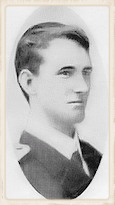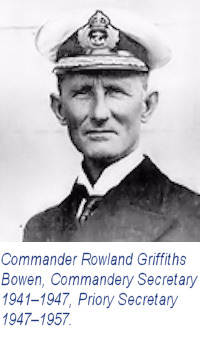
Navy Victoria
Network
Proudly supported by the Melbourne Naval Committee
Commander Rowland Griffiths Bowen OBE MID K St J RAN
|
He joined the Queensland Naval Brigade in 1900 and took a commission as a sub-lieutenant. The brigade came under the authority of the Commonwealth Naval Force in March 1901. At that time it was commanded by the Director Commonwealth Naval Forces Captain, William Rooke Creswell, a native South Australian who was at the time resident in Queensland and formerly the commander of Queensland Naval Brigade. With the creation of the Royal Australian Navy (RAN) on 10 July 1911, Bowen transferred to the new force as a full time officer at the substantive rank of lieutenant, with an annual salary of £325 and was posted as the District Naval Officer (DNO) at Thursday Island. In February 1914, he was appointed the Assistant District Naval Officer Melbourne, a position he held until the outbreak of the First World War. Perhaps due to the circumstances of the time or perhaps just serendipitous timing Commander Bowen married Agnes Grace Mary Bell on 14 August 1914 at All Saints Anglican Church, East St Kilda. On 19 August 1914 he was appointed Lieutenant in the Australian Naval and Military Expeditionary Force and sailed off to war on HMAS Berrima. The vessel was formerly the P&O passenger liner SS Berrima prior to the outbreak of hostilities and pressed into service by the Australian Government. Under terms agreed upon at the establishment of the RAN between the imperial government at Westminster and the Australian government, at the outbreak of war, the RAN was immediately put under the direct command and control of the Royal Navy as the Australian Squadron Royal Navy. The Australian Naval and Military Expeditionary Force was raised to engage the enemy in the Pacific and specifically tasked to destroy German wireless stations. The force first went into action in what was then known as German New Guinea. The then Lieutenant Bowen lead a raiding party of 25 reservists in an attack on an enemy wireless station at Bitapaka.
These actions by the raiding party commanded by Bowen were of particular consequence to the operation on German New Guinea as a whole. The incident lead to the false report of the strength of the Australian contingent reaching the acting Governor of German New Guinea, who ordered his small force to abandon the defence of the coastal belt with the military occupation of the colony following, without further opposition. Bowen was mentioned in dispatches for his actions in this engagement by Admiral Sir George Patey. This was a significant engagement for a number of reasons not least, of which was its importance in the Australian advance on the command elements of the Imperial German Army on New Guinea. The action received is described at some length in CEW Bean’s seminal 20 volume work, Official History of Australia in the War of 1914–1918. However, a review of the actions of Bowen, have draw some comment that on its face he breaches the rules of war by using an enemy combatant in this deceptive fashion. All commentary expressing opinions on this issue also make it clear that Bowen would not have known this at the time. Bean states: In the employment of a prisoner in this manner, under a threat, a breach of the rules of war appears to have been unwittingly committed. This was more liable to happen through ignorance in the early days of the war than later, when the Australian military authorities had supplied all officers with pamphlets defining the rules with regard to prisoners, and when lectures had been given and orders issued on these subjects. The consideration that loss of life to both sides was thus almost certainly avoided does not alter the legal position. On 13 November 1914, Bowen was appointed acting lieutenant commander in the Naval Expeditionary Force, later being returned to Melbourne as the Assistance District Naval Officer in April 1915 then to duties in the Navy Office later that year. In October 1915, his wife Agnes passed away leaving him with an infant daughter to care for. Keenly interested in the welfare of returned servicemen, 37 year old Bowen became the Foundation President of the Returned Sailors' and Soldiers' Imperial League of Australia, Victorian Branch (today known as the RSL) in 1916. On 1 May 1917 Bowen received his first posting to Perth, Western Australia, as Assistant District Naval Officer. On 22 November 1917, he married Corinne Elizabeth Bruce-Nicol in St George’s Anglican Cathedral Perth. In August 1919, he briefly returned to duties in Melbourne until 1 October 1919 when he was posted as District Naval Officer Tasmania. Bowen held this position until he was appointed District Naval Officer, Western Australia on 1 January 1923. Bowen held this position with distinction until his retirement from active duties on 1 January 1936 at the age of 57 years. During his time in Western Australia he was significantly involved in the life of the community generally. He was the first President of the Fremantle Legacy Club. He developed a keen interest in aviation and was known to fly a 32 foot (11.7 metre) experimental guider biplane. In 1923 Bowen was elected a Fellow of the Royal Astronomical Society and was also closely connected to other scientific study and research groups. He lectured on international relations and economics for over ten years and had worked on the State War Council for Victoria. Commander Bowen was prominently involved in the Fremantle centenary celebrations in 1929 and was an organiser of elements of two royal visits to Western Australia. At the completion of the visit of His Royal Highness the Duke of Gloucester, in October 1934, it is recorded that Bowen received ‘an autographed photograph of His Royal Highness as a token to mark his appreciation’. He was awarded the King’s Silver Jubilee Medal in 1935. Commander Bowen had been appointed as a naval aide de campe to the Governor General on 5 April 1922, which was an appointment he held with successive Governors General until his transfer to the Emergency List in January 1936. It is also noted in the reports of his retirement that Commander Bowen had served for ‘some years’ as a member of the council of the St John Ambulance Association in Western Australia.
On 14 January 1939 at the age of 60 years Bowen was transferred to the RAN Retired List. Upon his retirement from the navy, Commander Bowen took on the role of Secretary of the New South Wales Centre of the St John Ambulance Association. This was an important time not only in the life of St John but also of the country moving into the Second World War. This is a role he maintained until 1944 and between 1941 and 1944 he held it concurrently with his duties as the Commandery Secretary. In January 1940 Commander Bowen was appointed Deputy Secretary of the Australian Chamber of Aviation. This group was established to deal with such matters as additional civil aerodromes, civilian pilot training, safety requirements, subsidies to airlines, co-ordination with the Royal Australian Air Force and similar matters concerning aviation in general. In 1957 Commander Bowen moved to Canberra and was appointed an Officer of the Most Excellent Order of the British Empire (OBE) in the Civil Division in the 1959 New Years Honours List. The citation noted that he was ‘Secretary of the Order of St John of Jerusalem’. He died on 21 October 1965, survived by a son and a daughter. His biographical profile is included in the Australian Dictionary of Biography, which describes him as: Tall and distinguished in appearance, brisk in manner and speech, conscientious and inflexibly high-principled. Bowen probably commanded respect more readily than he inspired affection. At ease with his friends, he was a man of considerable charm and had a fund of amusing stories. Sources: |
 Rowland
Griffiths Bowen was born on 14 January 1879 at Taggerty, Victoria to
Welsh born parents David Bowen and Margaret Hughes. He
was the seventh child of this farming family. His father
David died when he was only seven years of age. It was the catalyst for the
family move to Petrie in Queensland where Rowland attended the local
state school until he gained employment with the Queensland Railways
as a clerk, a position he held from 1895 until 1911.
Rowland
Griffiths Bowen was born on 14 January 1879 at Taggerty, Victoria to
Welsh born parents David Bowen and Margaret Hughes. He
was the seventh child of this farming family. His father
David died when he was only seven years of age. It was the catalyst for the
family move to Petrie in Queensland where Rowland attended the local
state school until he gained employment with the Queensland Railways
as a clerk, a position he held from 1895 until 1911. Reports of the action state that the party was put ashore at
Kabakaul on 11 September. Bowen soon realised the necessity to move
through the bush and avoid the road which was really a narrow track. They were soon ambushed by a patrol of native soldiers led by three
German officers. One of Bowen’s party, Petty Officer G.R. Palmer,
shot one German in the hand. The native troops hastily fled. Bowen
acted equally quickly, he forced the wounded German, to move ahead
of the column, calling out to the German troops to surrender because
800 troops had landed. The feint was to indicate it was futile to
resist. During this incident, Able Seaman W.G.V. Williams – one who
remained on the track – was mortally wounded at 9.30am. In a later
skirmish Bowen was shot in the head by a sniper and evacuated to
Berrima for treatment; he was later mentioned in dispatches for
gallantry and promoted to Acting Lieutenant Commander in November
1914.
Reports of the action state that the party was put ashore at
Kabakaul on 11 September. Bowen soon realised the necessity to move
through the bush and avoid the road which was really a narrow track. They were soon ambushed by a patrol of native soldiers led by three
German officers. One of Bowen’s party, Petty Officer G.R. Palmer,
shot one German in the hand. The native troops hastily fled. Bowen
acted equally quickly, he forced the wounded German, to move ahead
of the column, calling out to the German troops to surrender because
800 troops had landed. The feint was to indicate it was futile to
resist. During this incident, Able Seaman W.G.V. Williams – one who
remained on the track – was mortally wounded at 9.30am. In a later
skirmish Bowen was shot in the head by a sniper and evacuated to
Berrima for treatment; he was later mentioned in dispatches for
gallantry and promoted to Acting Lieutenant Commander in November
1914. Upon
his retirement, Commander Bowen took twelve months furlough from the
navy and travelled to the United Kingdom prior to retiring to the
Sydney suburb of Vaucluse. Commander Bowen stood as a United
Australia Party candidate in the March 1938 New South Wales State
elections for the seat of King.
Upon
his retirement, Commander Bowen took twelve months furlough from the
navy and travelled to the United Kingdom prior to retiring to the
Sydney suburb of Vaucluse. Commander Bowen stood as a United
Australia Party candidate in the March 1938 New South Wales State
elections for the seat of King.